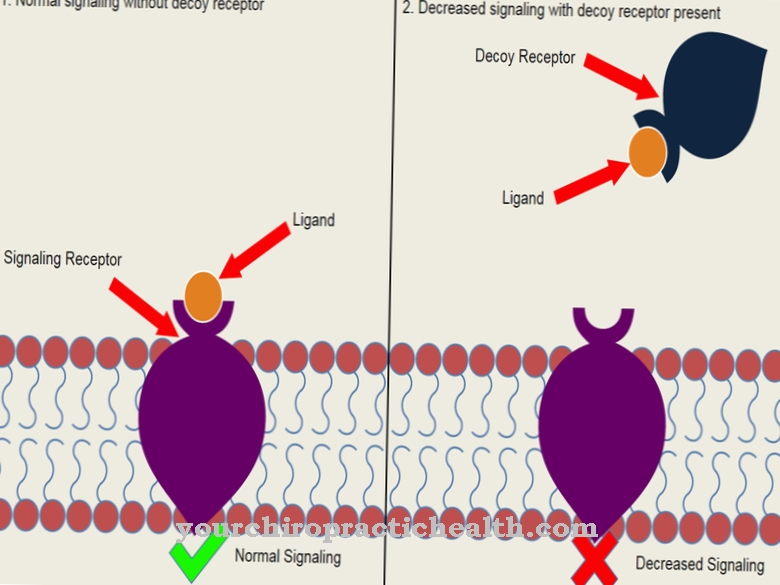The number of new skin cancer cases is increasing massively from year to year. In addition to the extremely dangerous black skin cancer (malignant melanoma), there are a number of "harmless" skin cancers, which are often referred to as "white skin cancer" because they are not as aggressive as melanoma. One form of these cancers is that Squamous cell carcinoma, often also called Spinalioma referred to as. Spinalioma is the second most common form of skin cancer.
What is a spinalioma?
.jpg)
Under a Spinalioma is a malignant skin tumor that can appear on the skin and mucous membrane and typically grows wart-like. In contrast to black skin cancer (melanoma), it has a relatively good prognosis.
Although the spinalioma rarely metastasizes when detected early, it can destroy bone and muscle tissue. Squamous cell carcinoma rarely manifests as lung or bronchial carcinoma, but very often (90%) as esophageal cancer or cervical cancer.
Often the spinalioma is shown to the doctor very late because it does not look threatening in the optical form of a wart, especially since it does not cause pain. In addition, patients are often more fixated on black skin cancer and are more likely to observe their dark moles.
causes
As the cause of that Spinalioma As with all forms of skin cancer, excessive exposure to the sun can be clearly identified. For this reason, skin cancer occurs primarily on so-called "sun terraces", i.e. areas of the skin that are often exposed to the sun, such as the nose, forehead, ears or back of the hands.
A significant increase in skin cancers can generally also be determined through visits to the solarium. Recent studies indicate that human papilloma viruses (HPV) may also be responsible for the development of the disease.
Since squamous cell carcinoma also occurs on the mucous membranes and can manifest itself in the form of cervical cancer, vaccination, which has been recommended for several years, may be useful.
Symptoms, ailments & signs
Spinalioma or squamous cell carcinoma is characterized by skin changes that do not always lead to the correct diagnosis. These are red, flaky patches of skin that look similar in many skin conditions. Even a differentiation between cancer precursor (keratosis) and actual carcinoma is only possible through a tissue examination.
In the case of precancerosis of the spinalioma (keratosis), reddened spots with more firmly adhering flakes are found on the skin. The skin changes do not heal. Over time, palpable lumps can develop there. The nodules have a layer of crusts and scales that break open at times in ulcers. This can already be skin cancer.
But the keratosis may only be at an advanced stage. The distinction is not possible just by visual appearance. Actinic keratosis does not have to turn into squamous cell carcinoma. It can also heal again. After the actual spinalioma has developed, the skin remains scaly and keratinized.
It feels rough. There is always a reddish to brownish discoloration of the skin on the affected area. Later on there is constant bleeding, whereby the wound crusts and scabs. The bleeding keeps coming back when the patient tries to scrape off the scab. It also creates a tough, painless knot. The cancer grows very slowly and very rarely forms metastases.
Diagnosis & course
_2.jpg)
The Spinalioma Therefore, it is not considered to be a very dangerous tumor, because it is detected early and metastasized very rarely with a size of up to 2 cm. If removed in good time, this skin cancer has a very good prognosis for complete cure.
Nevertheless, spinalioma patients should go to cancer follow-up care every three to six months over a period of five years and have themselves thoroughly examined for recurrences, i.e. recurrent skin cancer. In some federal states, this form of follow-up examination is part of the service provided by health insurance companies.
Complications
Without treatment, the malignant tumor spreads and increasingly destroys the surrounding tissue. Depending on the localization, this may result in functional disorders. Multiple involvement of the organs always leads to a low probability of patient survival. This can only be prevented with the help of timely surgery.
Damage caused by incisions in nerve tracts in the facial area may result in abnormal sensations or even symptoms of paralysis as a complication. These can be permanent or short-term in nature. The deeper the tumor has already penetrated into tissue structures, the higher the risk of additional damage from the procedure.
Excessive scarring is also possible in some cases. It usually poses an aesthetic problem for patients. Larger sections may require specific reconstruction of the skin areas. In the case of skin transplants, allergic defense reactions cannot be excluded. In general, there are no undesirable consequences after an operation if the tumor was discovered early.
A complete and straightforward cut allows for a full recovery with no cosmetic drawbacks. This does not always work satisfactorily in later stages. The occurrence of daughter tumors is therefore possible.
Proper removal of the tumor for a favorable prognosis includes plenty of surrounding, still healthy tissue. In addition, the draining lymphatic system is included. If this surgical leeway is missing, even a spinalioma that has already been removed can break out again after some time in the same or a different location.
When should you go to the doctor?
In the case of a spinalioma, medical treatment must always be carried out. Further complications or complaints can only be prevented through correct and, above all, early medical treatment of this disease. Since spinalioma is a cancer, regular examinations should be carried out even after successful treatment to prevent the tumors from spreading in the body.
A doctor should be consulted if the person concerned suffers from various changes in the skin. This can lead to redness or black spots on the skin. If these appear or if the skin complaints change in shape, size or color, a doctor should definitely be consulted. Permanent scaling or lumps on the skin can also indicate a spinalioma and should also be examined by a doctor. In some cases, the affected areas may even bleed.
In the case of a spinalioma, either a dermatologist or a general practitioner can be seen. In most cases the symptoms can be alleviated relatively well.
Treatment & Therapy
Usually will be Spinaliomas surgically removed and the removed tissue then examined histologically to confirm the diagnosis in the laboratory. This operation is usually carried out on an outpatient basis, but such interventions can also be carried out on an inpatient basis in special cases, for example in very elderly people or patients with additional, high-risk diseases.
In most cases, however, the health insurances only pay for outpatient treatment. The suspicious skin area is cut out as large as possible in order to avoid having to cut again. Nevertheless, it often happens that the histological finding shows that the spinalioma has not been completely removed, in which case a re-excision should always be carried out.
prevention
Since the influence of the sun's rays is considered to be the main cause of disease development, avoidance of excessive solar radiation must be mentioned as a preventive measure. Visits to the solarium are often played down, but have been shown to cause skin cancer. The more people are exposed to the sun or solar radiation, the greater their risk of developing skin cancer.
Since the papilloma virus is also suspected of causing squamous cell carcinoma, vaccination can also be useful, especially in young women because of the risk of developing cervical cancer. Parents should take action here, as young women should be vaccinated before their first sexual intercourse. A consultation with a doctor as to whether the vaccination makes sense in an individual case should always be made in advance.
Conspicuous birthmarks, especially those that have changed quickly, should always be shown to a qualified doctor.Detected early, all types of skin cancer have a favorable prognosis. The surgical procedure to remove the suspicious mark is usually comparatively uncomplicated, which is why risk patients should not be afraid to visit a dermatologist.
Aftercare
Follow-up care is extremely important with a spinalioma. There is a risk that the squamous cell carcinoma will recur at a later date. For this reason, dermatologists recommend that patients undergo a skin check-up every three to six months even after successful therapy.
These should be carried out over a period of five years. Recurrences and metastases (daughter tumors) usually show up within two years of the first therapy. As part of the follow-up care, tumor recurrences and secondary malignancies can be identified at an early stage and treated accordingly. The examinations of the patients are carried out regularly and depend on the type of tumor in question. The tumor parameters and the stage of the disease play an important role.
Imaging procedures such as sonography (ultrasound), computed tomography (CT) and magnetic resonance imaging (MRI) are important follow-up examinations after a spinalioma. X-rays can also be taken. The doctor also explains to the patient the risk factors for the development of squamous cell carcinoma and how they can be avoided.
If it is a high-risk patient who has been diagnosed with the disease at an advanced stage, the follow-up examination will take place in a special skin tumor center. All other patients can do follow-up care with their family doctor. As part of aftercare, patients should use a sunscreen that is high in sun protection factor on their skin every day.
You can do that yourself
If necessary, a spinalioma can recur at a later point in time. Therefore, ongoing check-ups are necessary after successful treatment. We recommend regular, six-monthly examinations of the entire skin surface over a period of at least five years. An important goal of the dermatological examination is the early diagnosis of a second spinalioma, for which the patient has a significantly increased risk.
The protection of the skin is even more important for the treated patient with spinalioma. Thus, excessive sun exposure on the skin is to be avoided. The best protection from the sun is suitable clothing. Therefore, sunscreen with a high sun protection factor should be applied regularly by the patient. This is especially true for people with fair skin types and a weakened immune system. Avoid sunburn in any case.
The skin must be protected from chemical influences. Avoid skin dryness. Soap-free products should therefore be used to cleanse the skin. The selection of the suitable skin care cream must be agreed with the attending physician. Dietary supplements such as selenium, vitamin A and beta-carotene should be added to the diet of the treated patient with spinalioma. These substances have been shown to protect against a new spinalioma.

.jpg)

















.jpg)


.jpg)





